A Mostly Robert E Howard Weekly Geekly for June 13 and June 20, 2025
This Weekly Geekly is both late and long. These things are related. There was so much potential content for a Robert E Howard themed Weekly Geekly that I got a little lost. As you know, everything is bigger in Texas, and that includes Rabbit Holes.
The Cimmerian glared about, embarrassed at the roar of mocking laughter that greeted this remark. He saw no particular humor in it, and was too new to civilization to understand its discourtesies. Civilized men are more discourteous than savages because they know they can be impolite without having their skulls split, as a general thing.
— Conan in The Tower of the Elephant, by Robert E Howard 1933
Though he created a number of memorable characters in his tragically short lifetime, there can be no doubt that Conan the Barbarian is the best known of Robert E Howard’s literary creations. I’ll be covering a lot of Howard’s other characters in this Newsletter, but for this week’s Oddity I thought I’d share some of the ways that Conan has been presented in popular culture outside of his literary origins. Let me preface this by saying that the character in these cultural presentations often have more in common with the pastiche version of Conan presented by Lin Carter, Sprague de Camp, and later authors and almost mere tangential connection with the Philosophic King version of Conan in Robert E Howard’s The Phoenix on the Sword, what I call “Gumshoe” Conan in God in the Bowl, or even the early illustrated versions of Conan from the Pulps.
Howard’s Conan was a thinking man who wore armor appropriate to the situation. Pop-Culture Conan is essentially Pop-Culture Tarzan with a sword. Having said that, Conan does wander around town in only a loincloth after his tunic gets shredded in a fight at the beginning of Tower of the Elephant and that is one of the best Conan tales. Howard’s Conan is also distinctly Celtic in background, which is something I wrote about at some length in a prior post discussing the literary merits of The Phoenix on the Sword. After all, there was a Celtic king named Conan Meriadoc1 and King Conn of the Hundred Battles is pretty famous. Howard himself wrote a tale about an Irish warrior named Conn who battled against Vikings (The Grey God Passes) that very much parallel’s Conan’s own battles against Vanir, such as at the beginning of The Frost Giant’s Daughter. Conan’s mythical Hyborean age borrows greatly from our own history and studying the history texts (including Plutarch) that were widely read in Howard’s lifetime help to give you a deeper appreciation for the character.
Episode 176: Conan the Patron of the Arts? (From the Archives)
For the end of Cimmerian September, I am republishing a slightly revised version of one of my earlier posts about the Conan character. The original version was published in August of 2023, when my su…
The point of all that prelude was to highlight that as enjoyable as Pop-Culture Conan is, the unfiltered Conan is a much richer and complex character. Nevertheless, Pop-Culture Conan endures. Sometimes in beautiful ways and sometimes is ways that boggle the mind. This week’s Oddity takes a walk through some of these representations.
If you aren’t a Howardian who’s read multiple versions of various Conan tales, I want to to take a moment to picture Conan in your mind. You’re picturing Arnold Schwarzenegger in the movie from the 1980s right? Bulging biceps and scantily clad in a film distributed by Universal Pictures (in the US) right?
Heck, I’ve read a ton of Howardian fiction, commentary on Howardian fiction, and wrote the above section arguing that Conan was Celtic and not Germanic and even I picture Arnold Schwarzenegger as my first thought. This shouldn’t be surprising, the film made $68 million in global box office in 1982 on a budget of $20 million. That’s the equivalent (using CPI) of making $210 million on a $60 million budget. Not quite major blockbuster, but significant fan base and profit. Of course, the film did even better after release and while it’s no Beastmaster for cable showings, it’s been played a lot and according to Paul Sammon in Conan the Phenomenon the film had grossed over $300 million total (unadjusted) by 2007 when you take into account video sales over the years.
Conan the Barbarian might not have been a blockbuster, but it was influential enough that Universal Studios Hollywood decided to create a stage show based on the film. For those of you who aren’t familiar with Universal Studios, it’s an odd amusement park that is on the actual Universal Lot where many of your favorite films have been shot over the years. It’s what I like to call the Tale of Two Cities of amusement parks. It is the best of parks and the worst of parks, though it has begun to shift more into the second category as time goes by. Needless to say, the amusement park side of things is heavily influenced by the film industry and includes a number of film/tv themed rides and shows.
When I was a kid, these included a Backdraft special effects show that showed us how safe film fire was by blowing filmic fire into your face, an ET Bicycle Ride, and the Back to the Future ride. There was The Wild Wild Wild West Stunt Show that ran from 1980 to 2002 and a Miami Vice Action Spectacular. The Wild West Stunt show is long gone and events like Halloween Horror Nights and Grinchmas use the space now. The Miami Vice Action Spectacular was replaced with the Waterworld show, which still runs today. Which says a lot for the fact that a film can be a huge flop, but still have impact in pop culture.
The Adventures of Conan: A Sword and Sorcery Spectacular replaced the older Castle Dracula stage production and ran from 1983 to 1993. It was replaced by Beetlejuice’s Rock and Roll Graveyard Review, which was replaced by Spider-Man Rocks, which was replaced by Fear Factor Live, which was replaced by Creature from the Black Lagoon: The Musical, which was replaced by the Special Effect Stage that ran from 2002 to 2023. This paragraph was the Universal Studios equivalent of Matthew Chapter 1: “Castle Dracula begat The Adventures of Conan…”
The Universal show is Pop-Culture Conan in full swing. It features Red Sonja and child friendly fun. There are a number of, all bad quality, videos covering the show and this was the best one I can find. I will say that even as hokey as it is, I wish I had been able to see it in person or that Universal had recorded it and made it available for purchase on DVD. It’s a fun pastiche that might be a bit to close to the comic book version of Conan for many people, but might have inspired a bunch of kids to read the real thing when they got home.
Speaking of things that might encourage someone to read the real thing. Back in the 1970s, Marvel Comics was experimenting with new ways to make money off of their existing properties and one of the ways they did that was through dramatic recordings of comic book stories. Sometimes these were released as comic books with a 45 record featuring the story and sometimes they were released as LPs with multiple stories and without the accompanying comic book. To this day I’m quite certain that the reason that Man-Wolf is my favorite Spider-Man villain is because of the Power Records booklet and record. I picked it up at a used bookstore as a kid and I was hooked. Spider-Man vs. Werewolf? Good stuff. Marvel did similar things with Conan the Barbarian and I’ve got to hunt down a copy of this album.
Marvel’s partnership with Power Records wasn’t the last time that Conan would have content produced to reach out to a younger audience. In 1992 Jetlag Productions and Sunbow Productions put together a 65 episode animated series called Conan the Adventurer (not to be confused with the live action series). The show was developed by veteran animation writer Christy Marx and was given a full two seasons. I recorded an interview with Christy Marx discussing her wide ranging career back in 2008 and I’m re-editing it (to remove many umms) and will share it soon.
As is typical of American animation projects, the show had a line of action figures. As you might guess, the Conan featured in this animated show, aimed at kids, deviated significantly from the Conan of the books, but it also demonstrated a pretty good understanding of the real canon. For example, Christy Marx and her team, made sure to include elements of the Weird in the tale. The central conflict of the series centers around the search for a mysterious “Star Metal” that is not only useful for making weapons of extraordinary quality, it also allows sorcerous users to open portals to other dimensions. Another weird element was the incorporation of Serpent Men similar to Howard’s own Serpent Men in his story The Shadow Kingdom (a Kull not a Conan tale, but the relationship between Kull and Conan is its own story). Christy Marx takes the Serpent Men and combines them with a foe from Conan’s first published story (Thoth Amon) in what I consider to be a very creative fusion. This new character is called Wrath-Amon and like his predecessor he is a servant of Set. In this case, Wrath-Amon seeks to use Star Metal to free set from his prison in the Abyss.
It’s pretty cool stuff for a kids cartoon and Christy Marx pushes the boundaries of what animation censors might allow regarding violence. First by having Conan’s parents turned to stone by Wrath-Amon and secondly, and more importantly, by making it so that when Conan “cuts” a Serpent Man with his Star Metal sword, he sends them back to their home dimension. This allows Conan to hack and slash away at the shapeshifting villains without the censor feared bloodshed. Yes, it’s bowdlerizing, but it’s creative bowdlerizing.
The series received a short run sequel series called Conan and the Young Warriors that was developed by J. Michael Reeves, one of the developers of the Gargoyles series. Reeves had no connection to the older series, but like Marx he was a long-time animation and children’s entertainment veteran who worked on everything from the Live Action Shazam! way back in the before times to classic animated shows like Batman: The Animated Series and much much more. Where Christy Marx sought to bend the restrictions of American animation television to fit with the fiction of Robert E Howard, Reeves took the opposite approach. Conan and the Young Warriors shares a bit in common with Captain Planet, the Dungeons & Dragons Cartoon, and other Ameri-Henshin Hero Shows. I found the show fun, but it’s much further from the core material than the prior series and only received 13 episodes.
Not all animation projects related to Conan have been aimed at children. There was a Red Nails animated film in development in the early 2000s, but that never saw the light of day. All that remains is some test footage.
The Lamentations of Luke Y. Thompson
It might just be a case of the Mandela Effect, but I could have sworn there had been a She-Ra Barbie doll manufactured in the 90s or early 2000s and yet there never was. Mattel finally made the leap this year and released an official She-Ra version of their empire building character and
has the full rundown and review of the product. It’s an interesting review, but if it gets you in the mood to buy a version of the doll you are likely out of luck. These figures sold out in minutes.Courtney Howard’s View from the Center Seat
Danny Boyle and Alex Garland maintain their ability to mine new ideas out of John Wyndham’s post-apocalyptic science fiction novel The Day of the Triffids and Courtney Howard’s recent review of 28 Years Later articulates how and why they’ve been so successful. Courtney doesn’t mention Wyndham’s novel, and it is a relatively obscure connection, in her review but she does a very good job of discussing how the film series is a salient critique of modern society. Wyndham’s novel contained a number of discussions critiques related to family, power dynamics, automation, science (Lysenkoism in particular), and industrialization. Boyle and Garland’s films touch on family in very interesting ways and as Courtney points out in this review has a timely critique of our modern vanity, a trait that Nietzsche associated with The Last Man.
“We have discovered happiness”—say the last men, and blink thereby.
They have left the regions where it is hard to live; for they need warmth. One still loveth one’s neighbour and rubbeth against him; for one needeth warmth.
Turning ill and being distrustful, they consider sinful: they walk warily. He is a fool who still stumbleth over stones or men!
A little poison now and then: that maketh pleasant dreams. And much poison at last for a pleasant death.
Of course, it is we who are The Last Man in such critiques and the protagonists in stories like 28 Years Later are dealing with the waste resulting from our narcissistic nihilism. This critique of the nihilistic decadence of modern society contrasted with the tragic superiority of a brutal world is a significant theme in Robert E Howard’s work as well, making 28 Years Later a semi-Howardian film. The quote from The Tower of the Elephant early in this Weekly Geekly is but one example of how Robert E Howard presented the contrast between civilization and barbarism. Howard, and his Conan character, valued the good and beautiful things about civilization (he made his career as a writer after all), but he saw civilizations as less moral than our more savage past. That isn’t to say that he saw barbarism and brutality as virtues, rather that he saw the savage past as more honest and therefore places with greater moral clarity.
Ever since I got my first hand me down copy of the Moldvay/Cook Basic Set of the Dungeons & Dragons Roleplaying Game I have been a huge fan of written examples of real play. To this day, I think back on the adventures of Morgan Ironwolf, Silverleaf, Fredrik, Sister Rebecca, and Black Dougal. The combat example where Fredrik falls to a single blow from a Hobgoblin was a quick example of how brutal D&D combat could be and Black Dougal demonstrated how important thieves were in adventuring parties and how they were not very good at their job.
has written up a play session of one of my favorite solo games, Four Against Darkness. It’s the first in the “Four Against” series of games by Andrea Sfiligoi and a great demonstration of the international nature of our hobby. I first became aware of Andrea Sfiligoi’s Italy based company Ganesha Games while reading a review of his miniature skirmish game Song of Blades and Heroes in a British wargaming magazine. This real play gives a glimpse of Sfiligoi’s ability to create a simple ruleset that allows for deep and meaningful play.Since this is a Robert E Howard themed Weekly Geekly, it’s only natural to include
’s latest discussion of Sword & Sorcery fiction and whether this is “The End” of the genre. It’s an important discussion to have because if Sword & Sorcery fiction ossifies into the rigid tropes of 1980s barbarian films like Ator the Fighting Eagle, Beastmaster, Deathstalker, Conan the Barbarian and every sword and loincloth derivative, then the future of the genre is pretty bleak. The only options in that case are to limit your creative choices to fit the narrow rules of the genre or to subvert them. While a lot of meaningful stories can be told in that space, the appeal will be limited and too much subversion of expectations can distance the genre from its core readers.The thing is that early Sword & Sorcery, the fiction that convinced George Heap, Fritz Leiber, and Michael Moorcock that the genre needed it’s own term apart from merely Fantasy, was a diverse and wide ranging genre that included tales far afield from mere sword and loincloth tales. I’ve got a fairly in depth discussion of the creation of the term Sword & Sorcery in my post discussing the difference between it and Planetary Romance tales.
Is Planetary Romance a Different Genre from Sword & Sorcery
Before diving deep into the waters of geek genre minutiae, I’d like to take a moment to thank of of my subscribers new and old. We just passed 400 subscribers and 2024 has been a year of semi-explosi…
The Conan of Howard’s tales is sometimes a sword and loincloth hero, but he is just as likely to be a character closer to a Douglas Fairbanks pirate or a Harryhausen Sinbad. He is a wandering protagonist who experiences a wide variety of adventures ranging from adaptations of the Lorelei tale to Black Mask style gumshoe detective tales like The God in the Bowl to novel length epic fantasy inspired by historical fiction. Fritz Leiber’s own Fafhrd and Grey Mauser are a far cry from sword and loincloth characters, yet their swords are commonly wielded against the Weird. There are a host of Sword & Sorcery anthologies and series worth your time as readers, and I’ll do a series of reviews on them as time permits, but one of my favorite anthologies is the Lou Anders edited anthology Swords & Dark Magic. Not only does that anthology feature some of the best writers in the history of American literature period (Gene Wolfe and Glen Cook), it is where I first encountered three of my favorite Sword & Sorcery characters.
It was in these pages that I met Garth Nix’s Hereward and Mr. Fitz as well as James Enge’s Morlock Ambrosius. Mr. Fitz is one of the most unique characters in literature. While Mr. Fitz happens to be one of the most power wizards to ever live, Mr. Fitz also happens to be an animated papier-mâché puppet. You read that correctly, Mr. Fitz is made of papier-mâché but that won’t save your city should Mr. Fitz choose to blast it to the Stone Age with magic. James Enge’s Morlock Ambrosius is the son of Merlin and demonstrates Enge’s ability to adapt elements of Arthurian legend into a weird Sword & Sorcery milieu. And that’s the key. Sword & Sorcery tales are a subset of fantasy where fantasy and weird horror are combined. It is often more down to Earth than literary fantasy, but that doesn’t mean it is any less fantastic. The cure for stagnation in Sword & Sorcery isn’t to make yet another subversion of Conan, rather it’s to understand that the genre allows for things as bizarre as papier-mâché puppet wizards.
made the trek down to Cross Plains, TX for the annual Howard Days festivities. I’ve been a member of the Robert E. Howard Foundation for years, but I have yet to make the journey. It is a bucket list trip for me as I would love to sit at the desk where Robert E Howard wrote so many of his stories and to look first hand at the landscape that inspired him. It would also provide an opportunity to meet internet friends from all around. has a post about two later Pulp era heroes, The Whisperer and The Avenger (aka Richard Benson), and discusses what works and doesn’t work with each character. I’ve long been a fan of The Avenger, though he is in many ways one of the most tragic of Pulp heroes. While he has a team (Justice Inc.) akin to the one that Doc Savage put together, Richard Henry Benson is more dependent on his team. His skill set and adventures put him on a par with DC Heroes like the Human Target and The Question. This is because of a biproduct he gained after the tragic disappearance of his family. His features were permanently frozen into a mask of death, but his frozen face is also malleable and allows him to become a Man of a Thousand Faces.Those of you who have been around a while might remember the piece I wrote about The Eye of Argon and the mockery and venom it has received over the years from fandom. That article is but one example, though I think one of the best examples, of how fan critics can go from being critical to being cruel.
writes a touch about his own experience with a negative review recently where he believes the reviewer went beyond criticism and into bitter negativity. GMaia has some valuable things to say in this short essay and I think I agree with Maia’s assessment regarding the review. A fairly popular role playing game review blog decided to review Maia’s adventure The God Towers of the Elophant (sic) in a review that included an amount of snark that far exceeded the price of admission for the adventure. You see The God Towers of the Elophant is Pay What You Want with a recommended price of $1, but with the option to get it for FREE. It’s one thing to write a bitter review when you’ve dropped $60, it is quite another when your basic point is “I want my FREE back!” Persionally, I typically wait for the sting to wear off so that I can write a critical but unbitter review. The only exception being for the film Ulysses Gaze, but that’s a tale for another time.
Since there are several good to excellent licensed role playing games based on the writings of Robert E Howard, I’m going to take a break from the normal single game mini-review here and provide a list of Howard based role playing games I think are worth checking out with an extremely brief micro-review. I’ll do more in depth reviews in the future. It goes with saying (yes that’s intentional), according to Appendix N of the Dungeon Masters Guide and the intros to Runequest and Tunnels & Trolls, that Howard’s fiction inspired almost every early role playing game. I won’t be including those. This will merely be a list of actually licensed games.
1. Conan Role-Playing Game by TSR
The Conan Role-Playing Game by TSR was written by David “Zeb” Cook during TSR’s Red/Green/Yellow Table era. This was an era where TSR sought to create a number of role playing games that appealed to younger or more inexperienced gamers by providing an easy to use and interpret resolution table to determine the success or failure (and the level of success) of actions in the game. Conan and Marvel were the two stand alone games during this period to use the table, but TSR also released a RGY Table version of Gamma World as well as the Zebulon’s Guide to Frontier Space rule book which provided RGY options for Star Frontiers. This was also a time of significant staff turnover at TSR and a number of staff left to form Pacesetter Games, a company whose game offerings mirrored the RGY Table trend at TSR.
With the exception of the Marvel game, the RGY games largely faded into the sea of forgotten role playing games. This might have been due to the fact that many older gamers thought the tables were childish. Early reviews of the Marvel game are very critical of it in comparison to games like Champions, but in that case the brand had staying power. It’s a shame these games are forgotten though because the systems are excellent and very easy to learn and play. The rules that David Cook designed for Conan live on in a generic fashion with the ZeFRS rules and I highly recommend checking them out. I’m including a copy of the PDF below.
As much as I liked the rules for the Conan game TSR produced, the ZeFRS set is an improvement in a couple of ways, key among them is that the rules provide opponents suitable to early adventurer talents. The Bestiary for the Conan game is a bit brutal for the newbs. Fellow fantasy fan
devoted an article to the Conan game a while back and I think you should check it out.2. Conan Modules for Advanced Dungeons & Dragons
In what could only have been an effort to confuse fans, TSR released a set of three Conan themed modules for Advanced Dungeons & Dragons around the same time they released the Conan Role-Playing Game, okay technically two Conan and one Red Sonja themed adventure but in the Marvel-verse they hangout.
These modules are well worth taking a look at for a couple of reasons. First, they are fairly well designed modules from David Cook (there’s that name again), especially for licensed adventures, that have enough background material to play a Conan campaign using AD&D rules. They also provide a couple of key optional rules that reflect changes in play style and the incorporation of genre conventions. One of these rules is the implementation of Fear Checks similar to sanity rolls in Call of Cthulhu, but dealing only with the immediate fight or flight reactions to fear. It’s a mechanic that makes Wisdom matter more for non-Clerics in AD&D and it’s one I can get behind fully. The game also added "Luck Points,” which were a pool of points that allowed characters to reroll failed actions. The final change was a change to the normal healing rules of AD&D that allowed relatively decent survival in a world without healing magic. In this setting, characters heal half their Constitution score in HP every day of full rest. Two of these rules are shifts towards the modern use of things like “inspiration” and “healing surges/long rests.”
3. GURPS Conan: The World of Robert E. Howard’s Barbarian Hero
If there was ever a rules set that could easily be adapted to the gritty reality of a Sword & Sorcery setting it’s Steve Jackson’s GURPS rules set. The Generic Universal Role Playing System is easy to learn and easy to play, but with a baseline of game play that favors low magic fantasy settings. The game can handle higher magic settings, but that’s best left to experienced players. The key to running and playing GURPS is to K.I.S.S. (Keep It Simple Sir!) and use only the rules you need. Don’t add all the bells and whistles, but add them if you need them. Howard’s Conan is a good fit and GURPS Conan is a great book to add to your gaming collection, even if you don’t play GURPS.
4. The Savage World of Solomon Kane
Conan isn’t the only Howard character to get his own role playing game. A few years back, Pinnacle Entertainment Group licensed the Solomon Kane character from the holders of Howard’s IP and the created The Savage World of Solomon Kane role playing game. It was an excellent game that sold well enough that it remained a staple of the Pinnacle product line. Time passed though and Monolith Games, publishers of a great Batman board game and a Batman RPG I’ll be reviewing in the future, attained the game license for the character and published a beautiful board game based on the Solomon Kane character. This license was expanded to include the role playing game license and they recently re-released a new version of the older game.
5. Conan the Roleplaying Game
With the release of the first OGL in the early 2000s, Wizards of the Coast opened the floodgates for other game companies to publish games that were compatible with the Dungeons & Dragons rules set. One of the most successful companies in this regards was the UK based Mongoose Publishing who released three d20 based Conan Role Playing Games, a first edition that aligned with 3rd Edition D&D, an Atlantean Edition that cleaned things up, and a second edition that aligned with Edition 3.5. In addition to core rule books, Mongoose published a library of sourcebooks for the game and these are definitely books that you should add to your gaming collection if you are a fan of Conan.
6. Conan Adventures in an Age Undreamed Of
In 2015 British company Modiphius acquired the license to a Conan role playing game from Conan Properties and released a Conan role playing game as one of their cornerstone games for their new 2d20 game system. The 2d20 game system was designed by Benn Graybeaton, Nathan Dowdell, and Jay Little and is a flexible and innovative game system. Jay Little’s particular flair for innovation can be seen in a number of places in the game mechanics. While none of the mechanics are as revolutionary as what he did for Warhammer’s 3rd Edition, a game system that wasn’t initially embraced but now has tons of fans when the mechanics were applied to other IP, there are some very interesting innovations. The Conan 2d20 game includes a character generation process that tells a story in a manner similar to the old Traveller storypath system and the combination of skills and talents echoes the excellent system in Feng Shui. The core mechanics involve a “success counting” system where you roll multiple dice (typically 2d20) and count the number of successes rolled. There are additional factors that enable critical rolls to result in additional successes, but difficult tasks usually require more than a single success. It’s a system that combines familiar d20 mechanics and storytelling systems like Vampire. It’s a damned good game and like the Mongoose rules set, it has a library of very good sourcebooks.
7. Conan: The Hyborian Age
Just as Monolith games was able to expand their Solomon Kane board game publication and acquire the rights for a role playing game, they recently expanded on their Conan board game rights to create a Conan themed role playing game. The game was funded on Kickstarter and should be hitting shelves soon. Unlike when they acquired the rights for Solomon Kane, this time they designed their own game mechanics. While not expressly based on the Savage Worlds rules set, Conan does use a step die system with the addition of an innovation called the “Flex Die” where characters have a chance to do something amazingly well if their Flex Die rolled its maximum value. The system is solid, but initial reviews of the game have been mixed due to the inclusion of a discussion of Safety and Player Comfort in the Quickstart rule book. Safety tools are a hot topic in the game community for a variety of reasons that deserve their own post in the future. As someone who has played games with a variety of age groups as well as a variety of player types, I can see value in having advice for how to navigate sensitive issues and to provide a comfortable experience for all your players. I can also see how this advice might want to expand beyond tools developed for specific communities outside of gaming.
Okay, those weren’t really micro-reviews so much as mini-reviews. I’ll try for micro on the music recommendations because there’s a ton of Howardian inspired music too.
Let’s start with the 1972 Marvel Comics themed Prog Rock album from the band Icarus.
This album features a number of progressive rock and roll songs inspired by characters from Marvel Comics, including everyone’s favorite Cimmerian.
While there has long been a connection between Metal and Sword & Sorcery, the person who best personifies this connection is Yngwie Malmsteen. I find it hard to even think about Sword & Sorcery without hearing his song I am a Viking echoing in the back of my mind. It turns out that either he or Universal Studios agree with my assessment as he did a song for the Universal Studios Conan show I mentioned in the Weekly Oddity.
Okay, this isn’t Conan related, but it’s Metal related. Zakk Wylde has had a long career as a Metal guitarist and in this video he puts to shame anyone who refused to learn to play guitar because the guitar their parents bought them wasn’t cool enough. If Zakk can blast out Black Sabbath tunes on a Hello Kitty Min-Guitar, we can’t blame the instrument for our laziness or lack of discipline.
Almuric’s bassist Jaron Evil has written Sword & Sorcery stories in a couple of DMR Books anthologies, including "The Chamber of Juleptsu by Jaron Evil (Almuric) in Swords of Steel volume 3. DMR Books is one of my favorite small publishers of Sword & Sorcery, and adjacent, fare. They got their start as a publishing house dedicated to the connection between Metal and Sword & Sorcery and their early anthologies were filled with weird tales by Metal artists. D.M. Ritzlin quickly expanded their offerings and they have become a valuable resource for any Sword & Sorcery fan. Their next anthology Celtic Adventures will likely be of interests to
and it includes Robert E Howard’s People of the Dark, a tale that has A Conan, but not THE Conan. It features art from Jim FitzPatrick and a number of stories I’ve never read before.Almuric is named for a Robert E Howard Romantic Fantasy story and their music is very Sword & Sorcery.
While I was roaming the internet looking for Robert E Howard music, I stumbled upon Celestial Quill who have both a song inspired by Robert E Howard’s Conan tale Queen of the Black Coast as well as a song dedicated to the literary legacy of Howard himself. The Soundcloud song is the Howard song and the YouTube video is the Conan song. They have an interesting, and more mainstream, sound. Imagine if you will Tori Amos decided to make music inspired by Robert E Howard and you’re not far from the mark, keyboards and a pleasant singing voice. Not quite Tori Amos, but that’s a pretty high bar for comparison and still enjoyable.
I don’t think I could have done this list of recommended songs without adding Conan Look at My Life. It’s a parody of the Neil Young Classic Old Man from the album Harvest. Old Man is one of my favorite songs, but Conan Look at my Life hits it out of the park.
Basil Poledouris’ soundtrack for Conan the Barbarian is undoubtedly the best thing about the film. I enjoy the movie, but the score is one of the best compositions of the 20th century. It’s emotive, powerful, and subtle. I begin every D&D session I run with Anvil of Crom. It lets the players know that metagaming time is over and it’s time to get to business playing.
Last, but not least, here’s a little tune from a band named Conan called Hawk as Weapon. It was recommended to me on the Twitter and it’s growing on me.
I’m going to get even more micro-here in the film recommendation section, but I want to point out that this isn’t so much a recommendation section as a “based on section.” I’ll tell you within the micro-reviews if it is an actual recommendation or not. I have, however, ranked the films by “greatness.” The higher on the list, the more I recommend them.
The Whole Wide World is an underrated film that covers Robert E Howard’s long friendship and relationship with Novalyne Price. It stars Vincent D'Onofrio as Robert E Howard and Renée Zellweger as Novalyne Price. It’s a beautiful and sad portrayal of Robert E Howard and one of my favorite romantic films. D'Onofrio manages to capture the complexity of Robert E Howard that eluded people like Sprague de Camp and presents him as a real person, flaws and all. This was the movie that made me fall in love with Zellweger as an actress and it is among her best performances.
The 1982 Conan the Barbarian directed by John Millius is an excellent film that catapulted Arnold Schwarzenegger into superstardom. For all the ways that it varies from the source material, it is a compelling film. As much as I like Arnold in general as an actor, he knows his range and stays in it most of the time, he is probably the weakest link in this film. James Earl Jones is great as Thulsa Doom (a Kull villain) and William Smith is fantastic as Conan’s father. Other actors give very strong performances throughout and the effects, while dated, hold up.
Sometimes a film gets everything except the character wrong and that’s the case with 2012’s Solomon Kane. From the back story to the curse to the tale itself, this movie has very little to do with Howard’s Solomon Kane and yet James Purefoy nails the character and brings such dour sincerity to the film that it completely transforms the film. While there are many entertaining moments in the film, it is Purefoy who caries this film on his back and makes it his goal to win you over. The more I resisted, wanting references to my favorite tales, the more Purefoy’s sincerity and work drew me in. I shouldn’t like this film as much as I do, but I do.
The 2011 Conan the Barbarian film presented a Conan that was physically both closer and further away from Howard’s character. Jason Momoa is a beautiful specimen of a man who has the strength and grace of Howard’s Conan, but is not remotely Celtic. Of course, neither was Arnold so those of us wanting a Timeline Era Gerard Butler (and yes, he would have been perfect) still have to wait. This film is very much a Roy Thomas comic book version of Conan, but I enjoy the film and Momoa is having a blast in the role. He’s not quite sincere enough to carry the film on his back and so this film is only a guilty pleasure where Solomon Kane is a go to film.
If you want to watch Roy Thomas’s comic book Conan, then there is no better example than Richard Fleischer’s 1984 Conan the Destroyer. The movie has appropriate Weird fiction nods (Dagon for goodness’ sake), but the dialogue and action are straight from the Marvel pages. Not surprising as Roy Thomas was one of the writers, but if you’re looking for grimdark then this isn’t it. It’s four color Conan. I happen to like four color Conan, but it’s not for everyone.
Speaking of guilty pleasures, there's 1997’s Kull the Conqueror starring Kevin Sorbo at the peak of his Hercules popularity and therein is the problem with the film. This version of Kull is so tongue and check, with added hair metal, that when Kull speaks the famous words “By this Axe! I rule!” he sounds like a surfer claiming his territory and pushing out those trying to make sure the beach stays “Locals Only!” Given how many Easter Eggs there are in the movie to Harryhausen films, and given that it does actually include elements from Kull stories, I’m forgiving of this film, but let’s just say that it’s in the same tier as Deathstalker II, the better Deathstalker film.
Is that an example of Robert E Howard and Tolkien sharing a common antecedent reference?





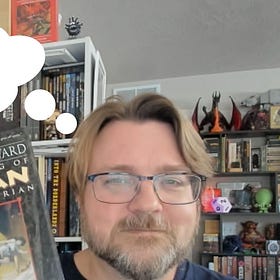








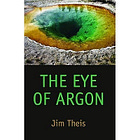


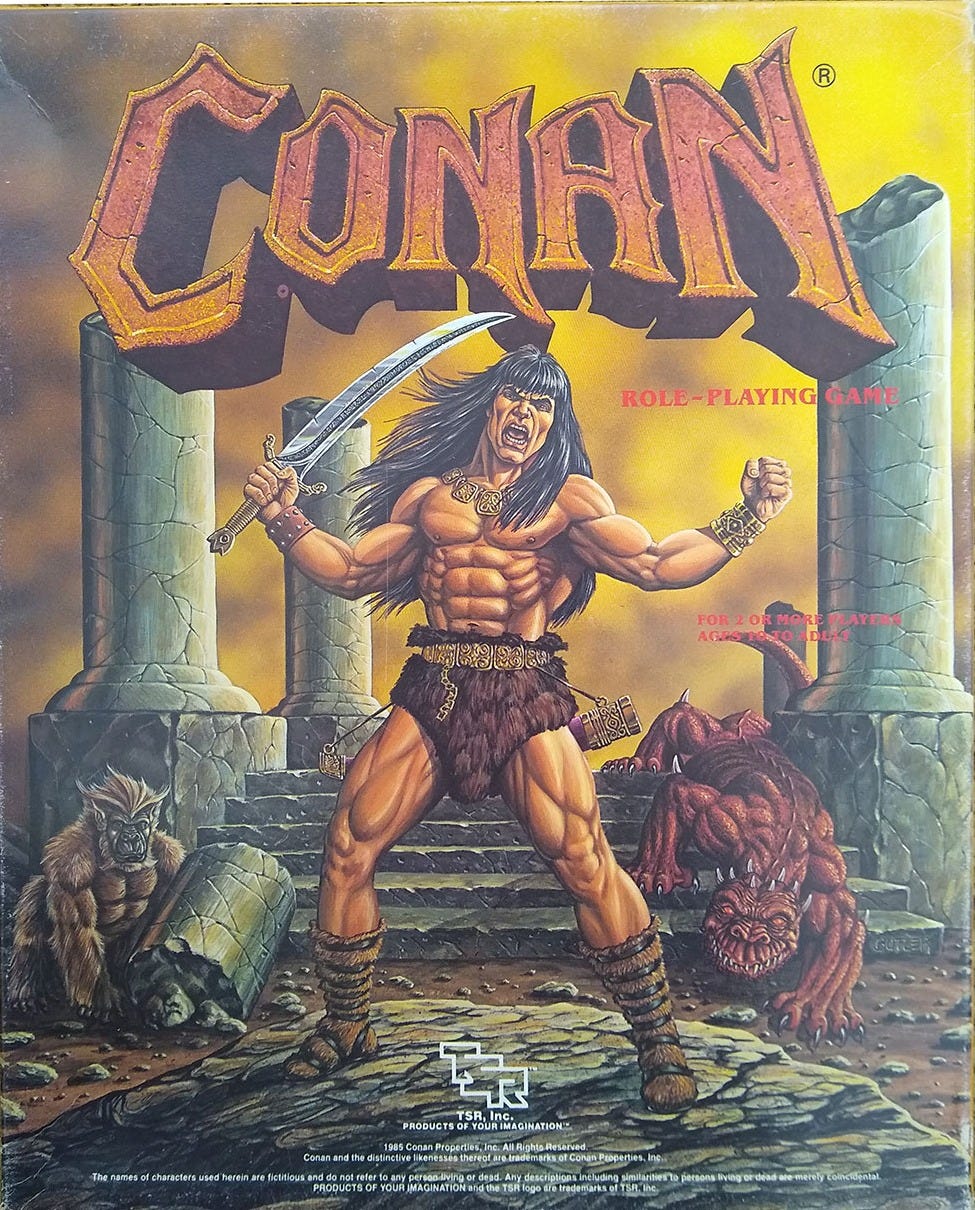


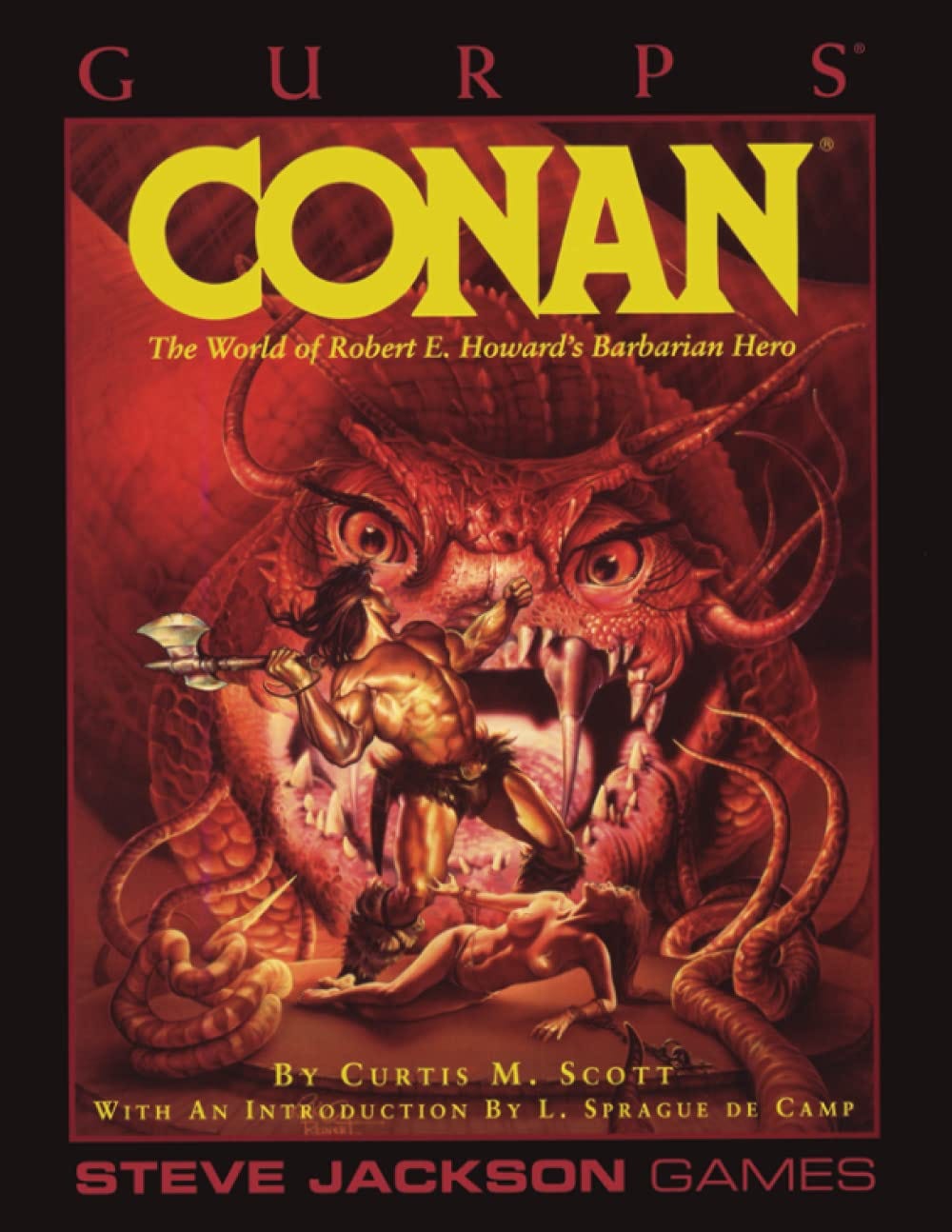
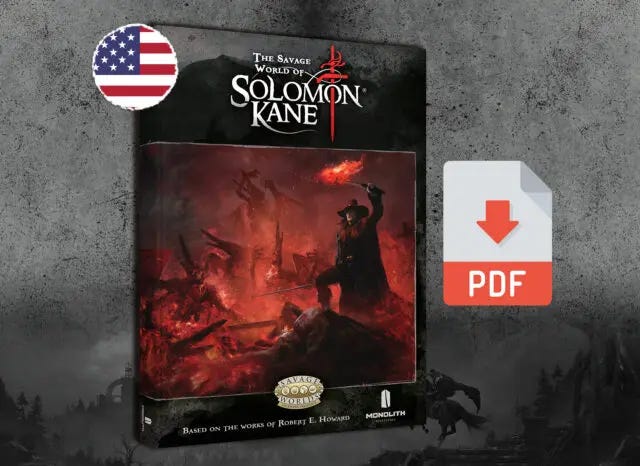




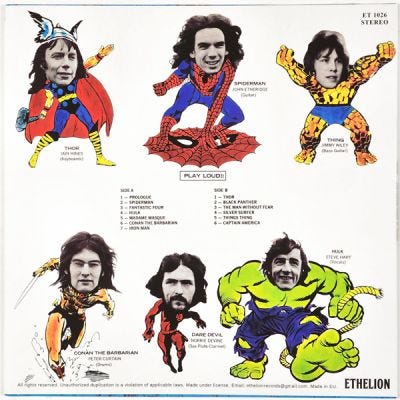
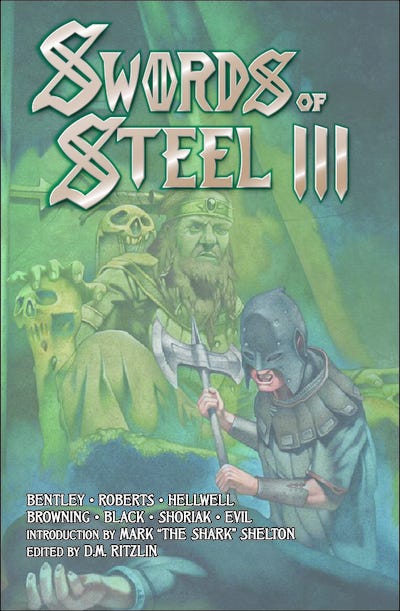

Big thing I remembered when I saw the Conan stage show was he did a He-Man style transformation out of his clothes in a pillar of steam and said "By the power of Crom!" Years later I would find out the show was directed by Gary Godard, who would go on to direct the Masters of the Universe movie. (and later, be justifiably canceled for horrible misdeeds)
Thanks for the mention, Christian!